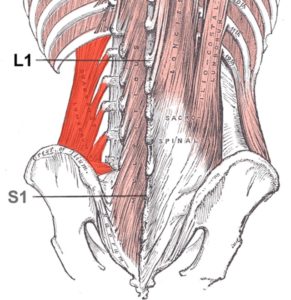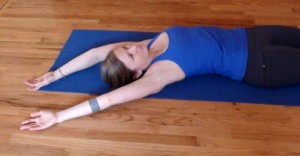The picture above depicts a quadratus lumborum stretch that attempts to isolate this lower back muscle (though muscles don’t really work in isolation).
The quadratus lumborum attaches the pelvis to the rib cage and the spine in between and is involved in any stretch to the side and the return from the side back to the midline.
It can lift or hike pelvis up and it is also involved in breathing, helping with forced expiration.
 A quadratus lumborum stretch, while necessary, doesn’t often address the intensity of our problems with this powerful muscle.
A quadratus lumborum stretch, while necessary, doesn’t often address the intensity of our problems with this powerful muscle.
From our perspective this muscle is one of the key losers is the war on posture.
If you lean backwards when you stand and walk which we think everyone does, your quadratus lumborum is always going to be short and tight.
You are forever shortening these key muscles by leaning backwards and compressing the spine.
So while we think the most important thing you can actually do is to stand up straight correctly, as opposed to your perception of straight which has you leaning backwards all the time (this concept in and of itself is the fodder for endless posts), learning a quadratus lumborum stretch or two will certainly help you to change this muscle and gain a better awareness of it.
The stretch we offer in the picture above isn’t particularly deep and meant more to bring an awareness of the muscle that anything else.
The same stretch done sitting or standing is similar will have a much different effect. Laying down flat to experience this quadratus lumborum stretch will help you connect to this muscle and get an understanding of what it does and how it tone is affecting your body and its movement patterns.
Quadratus Lumborum Stretch
- Laying on your back extend your arms over your head.
- Stabilize your legs and pelvis and arc your trunk to the side
- You want to lengthen and stretch the area between the pelvis and the rib cage.
- Try to keep both sides of the rib cage on the floor and you stretch.

